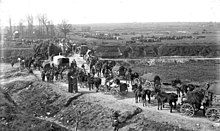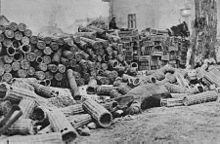Logistics in World War I
Logistics in World War I was the organising and delivery of supplies to the armed forces of World War I.
Initial stages of the war

With the expansion of military
The main method of transportation of supplies at the start of the war was still by horse due to the lack of available alternatives in 1914, similar to that of the inclusion of cavalry within the armed forces, and the fast pace of the war in the first part of the war. When World War I started, the capabilities of rail and horse-drawn supply were stretched to their limits. As the war progressed it became increasingly difficult to supply soldiers in the traditional way by horse and carriage due to conditions at the front. The supply routes became muddy and impassable, improvement to artillery on both sides and other tactics meant that supplies became increasingly delivered under cover of night and were considerably slowed down.
Trench warfare and blockade of Germany

However, as the war ground down into static trench warfare it became easier for armies to support their troops with the use of the
On the seas, the British
In June 1918 the Allies organized the Military Board of Allied Supply, which proved to be an invaluable mechanism for coordinating logistical requirements for armies working in close proximity during the final battles that autumn. The Board's report contains overviews of the logistical systems for the principal Allied armies.[2]
United States
The trans-Atlantic distances and the American inexperience at large scale operations combined to make support of the American Expeditionary Forces (AEF) extraordinarily difficult. Mass production of munitions, including cargo ships, did not reach full potential until near the end of the war. In the meantime, the United States relied upon European allies for most weapons and upon Britain for shipping. In France, the Americans built or improved ports, railroads, depots, and other facilities to move the supplies to the front. Slowly the Americans learned the multiple functions associated with supporting a large-scale conflict, which allowed the AEF to operate as an independent force. Experience gained in World War I proved invaluable during later conflicts.[3]
See also
- Military logistics
- Blockade of Germany
- First World War glass–rubber exchange
- Services of Supply, American Expeditionary Forces
References
Citations
- ^ Creveld, pp. 138–141.
- ^ “Report of the Military Board of Allied Supply” 2 vols. Washington: Government Printing Office, 1914.
- ^ Leo P. Hirrel, “Supporting the Doughboys: US Army Logistics and Personnel During World War I” Ft. Leavenworth: Combat Studies Institute, 2017. Available at no cost.
Sources
- Barnes, Alexander F. (2009), "Over There: Army Expeditionary Forces Logistics in World War I", Army Logistician, 41 (4)
- Brown, Ian Malcolm (1998), British Logistics on the Western Front: 1914–1919, ISBN 0275958949
- Hirrel, Leo P. "Supporting the Doughboys: US Army Logistics and Personnel During World War I." Ft. Leavenworth, KS Combat Studies Institute, 2017. online at no charge
- ISBN 0-521-21730-X
- ISBN 9780521773522
- Sheffield, Gary (2007), "Logistics", War on the Western Front, Osprey Publishing, pp. 41–42, ISBN 9781846032103
- WWI water carrier restored by Kent historians, BBC News, 18 April 2012
